Galant Schemata
1/95
There's no tags or description
Looks like no tags are added yet.
Name | Mastery | Learn | Test | Matching | Spaced |
|---|
No study sessions yet.
96 Terms
Folia
A minor-mode schema in 3/4 consisting of two 8-bar phrases. Both phrases share the first 6 bars, each with one structural note: ①—⑤—①—♭⑦—♭③—♭⑦. Phrase 1 ends with a half cadence (①—⑤), phrase 2 with a clausula basizans ①–⑤—①, bar 15 having 2 structural notes, ① & ⑤.
Folia
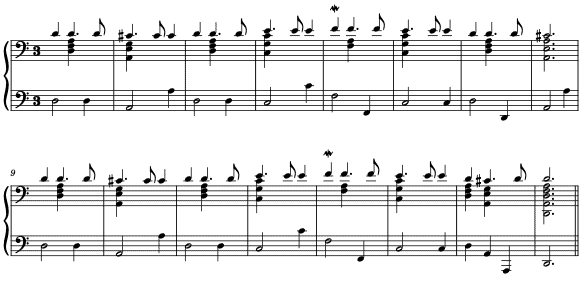
Jupiter
Dichotomous, proposta schema that features a ➊–➋…➍–➌ treble line and can be set with several counterpoints in the bass.
Jupiter

Jupiter
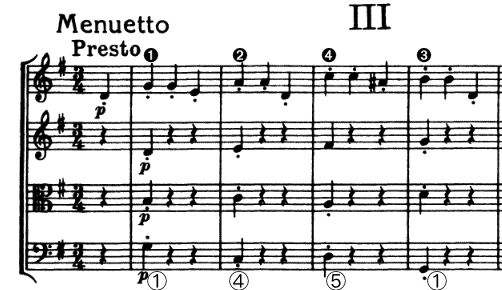
Pastorella
A dichotomous schema that features a ➌–➋…➍–➌ treble line and can be set with several counterpoints in the bass.
Pastorella
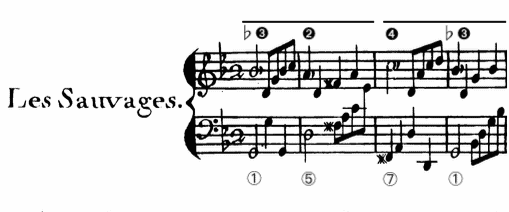
Aprile
A dichotomous schema that features a ➊–➐…➋–➊ treble line and can be set with several counterpoints in the bass.
Aprile

Jupiter
Aprile with a ①–②…④–③ Bass Line is equivalent to…
Meyer
A dichotomous schema that features a ➊–➐…➍–➌ treble line. As for the counterpoint in the bass, there are several possibilities including ①–②…⑦–① and ①–②…⑤–①.
Meyer

Indugio
Essentially a pedal point on ④ set with a sixth chord or a 6/5 chord used to postpone the conclusion of a cadence.
Indugio

Circular Indugio
The bass goes stepwise from ④ to ⑥ and back to ④, the treble in parallel sixths from ➋ to ➍ and back to ➋, while the middle part has a pedal point on ➊. Used to delay the conclusion of a cadence.
Romanesca + Prinner + Modulating Prinner

Quiescenza
A tonic pedal point with four or five sonorities, 5/3 – [7♭/5/3 –] 6/4 – 7(♮)/4/2 – 8/5/3, and a ➎–➏–➐–➊ or ➊–♭➐–➏–(♮)➐–➊ treble line that can be used as a proposta schema or occur in a closing passage.
Quiescenza
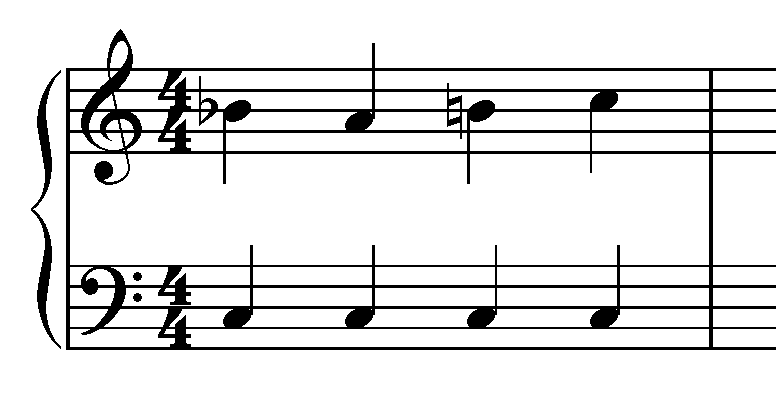
Quiescenza-Ponte
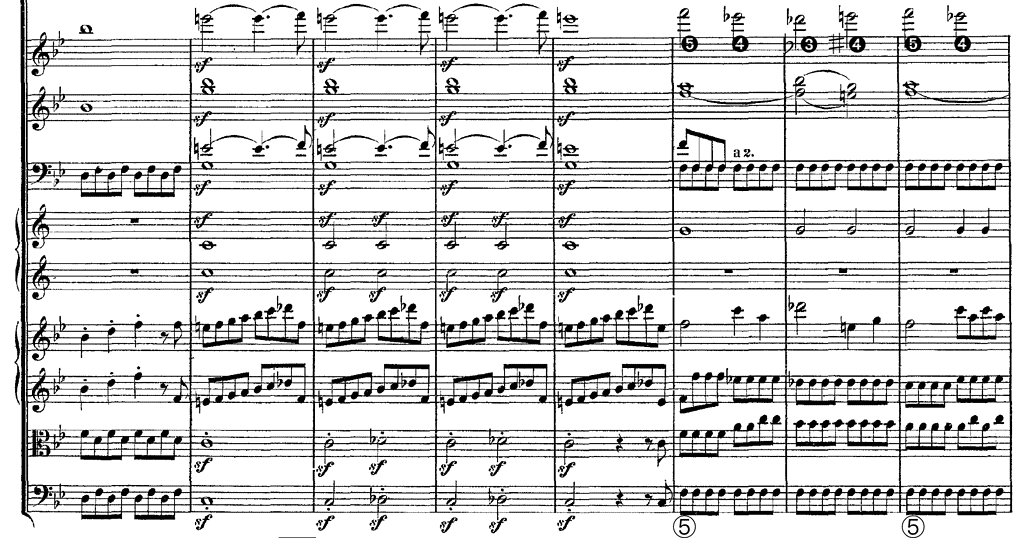
Paired Do-Re-Mo
A proposta schema that, due to the addition of an extra Re, consists of a pair of stages. The first pair presents a Do-Re snippet, the second a Re-Mi snippet. The first pair acts as a question, the second as the answer.
Paired Do-Re-Mi

Paired Do-Re-Mi

Chromatic Paired Do-Re-Mi
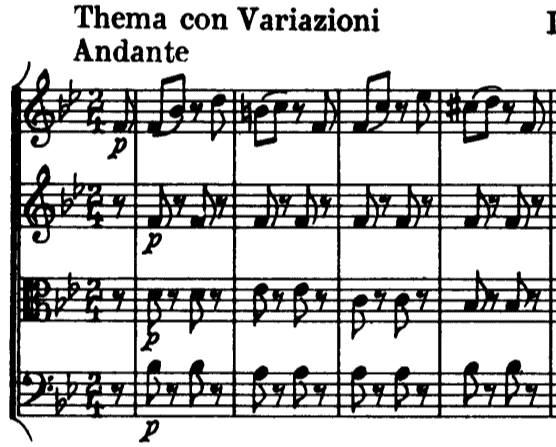
Do-Re-Mi
A proposta schema often featuring a ➊–➋–➌ snippet in the melody and a ①–⑦–① snippet in the bass.
Do-Re-Mi
D. Cimarosa, Keyboard Sonata (Allegro) in C major C 56, bars 1–5

Do-Re-Mi in the Bass with Mi-Fa-Sol in the Melody
J.S. Bach, French Suite No. 5 in G major BWV 816, Allemande, mm. 1–2 (see m. 1)

Stepwise Monte-Romanesca
A rising sequential pattern in which each segment consists of a descending step in the bass with each subsequent segment one step higher than the previous one. The first bass note of each segment is usually set as a triad, the second as a sixth chord.
Two-Part Stepwise Monte-Romanesca

Two-Part Stepwise Monte Romanesca with Tonicization
L. van Beethoven, Piano Sonata no. 21 in C major op. 53 ‘Waldstein’, Allegro con Brio, bars 12–20
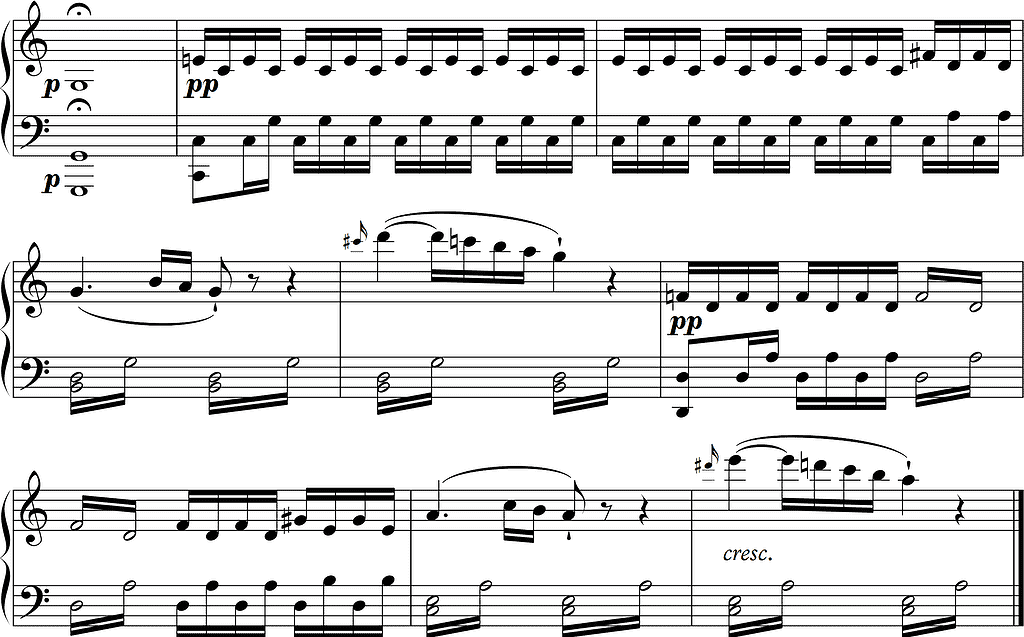
Leaping Monte-Romanesca
A bass motion that rises a fifth and falls a fourth, regardless of the setting, or, more specifically, to that bass set with canonic imitation in the upper parts based on a line alternating rising fourths and falling steps, including 4–3 suspensions.
Two-Part Leaping Monte-Romanesca

Monte
A sequential schema in which each segment constitutes a cadence, often a ⑦–① cadence or clausula cantizans as well. Ascending pattern starting in the subdominant key.
Two-Part Monte
J. Riepel, Anfangsgründe zur musicalischen Setzkunst — I. De Rhythmopoeïa, oder von der Tactordnung
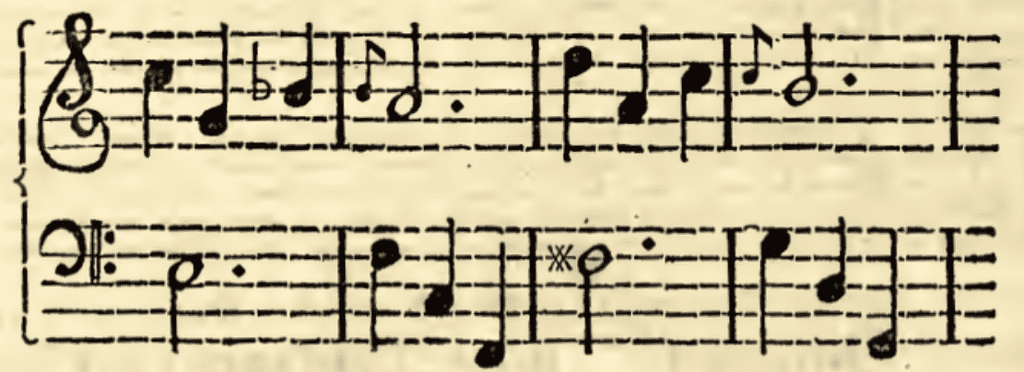
Major-Key IV–V–vi Three-Part Monte
J. Riepel, Anfangsgründe zur musicalischen Setzkunst — IV. Erläuterung der betrüglichen Tonordnung

Fonte
A descending sequential pattern with 2 segments, each segment constituting a ⑦–① cadence with a ➍–➌ melody. Segment 1 is written in the minor key of the supertonic, segment 2 in the main major key. Regularly opens the second half of a (rounded) binary form.
Fonte

Fonte with ⑤ Inserted in Between ⑦ and ①
D. Cimarosa, Cœli voces, aria for alto Avis nascente aurora, bars 33b–36

Fonte With The Hermaphrodite Note
W.A. Mozart, Keyboard Duet in B flat major KV 358/ii, Adagio (in E flat major), bars 27–30
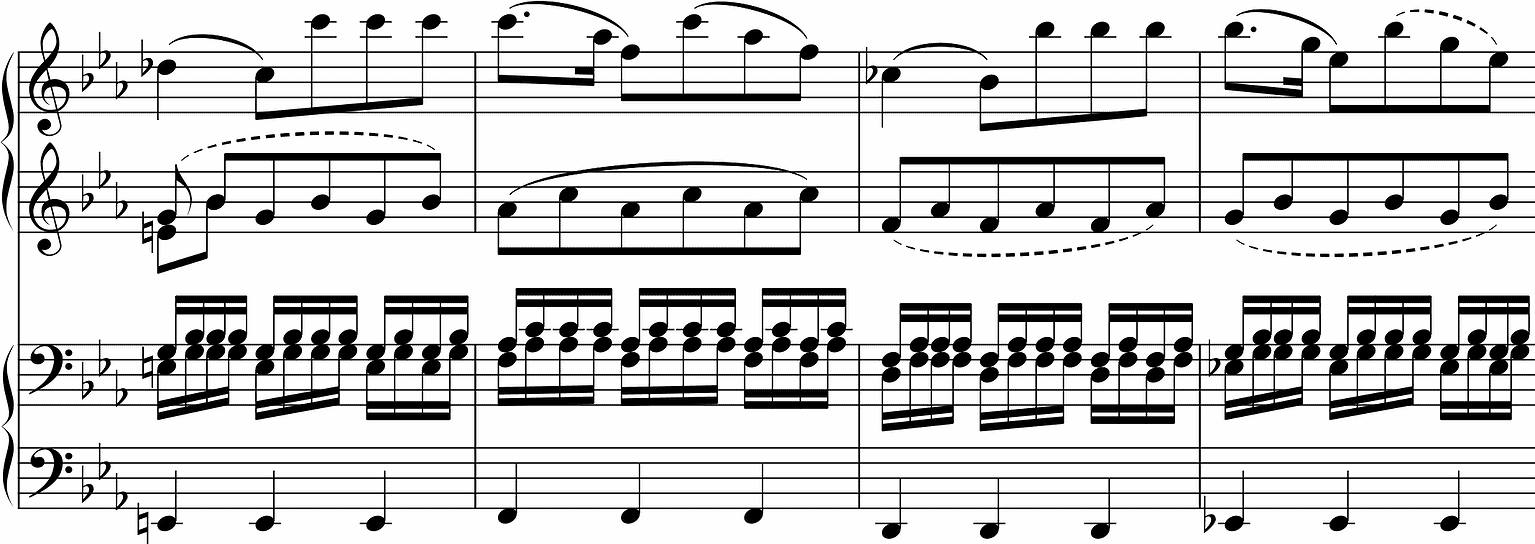
Prinner
A ④—③—②—① descent in the bass, a ➏—➎—➍—➌ descent in the upper voice (in parallel thirds with the bass) and, if in three parts, another upper voice that produces a ➊—➊—➊-➐—➊ melodic progression.
Prinner
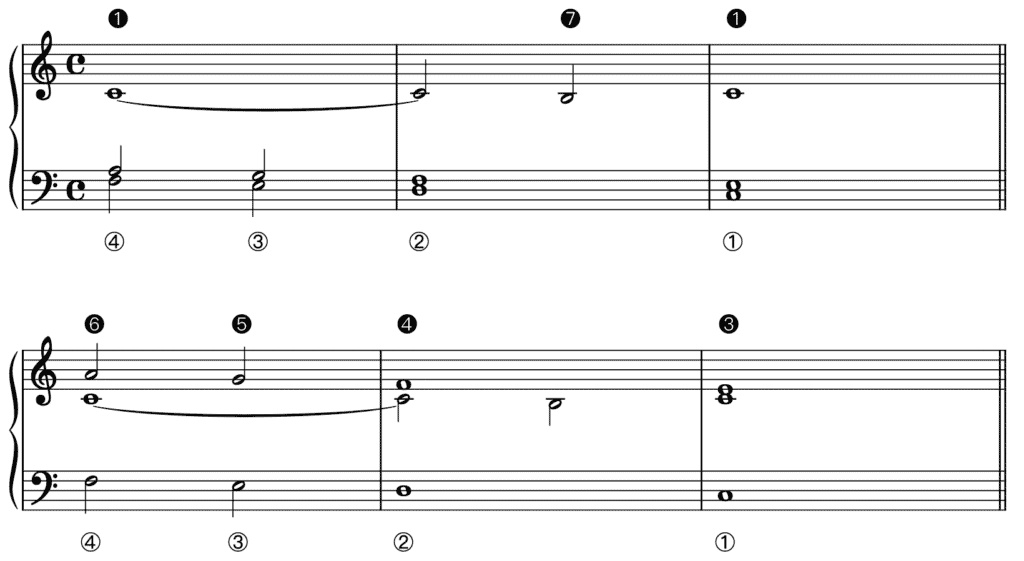
Traditional Prinner With a Stationary Line Throughout

Prinner

Prinner
A. Corelli, Sonata for Violin and BC in F major, op. 5 No. 10/i, Preludio Adagio, bars 1–2 (see mm. 1.4–2)
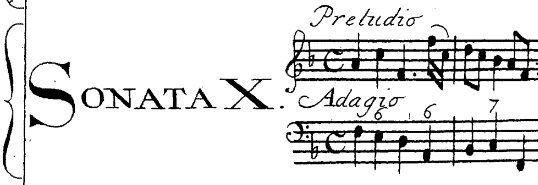
Prinner

Prinner
J.B. Wanhal, String Quartet in A major Bryan A4/i, Allegro moderato, bars 16–17
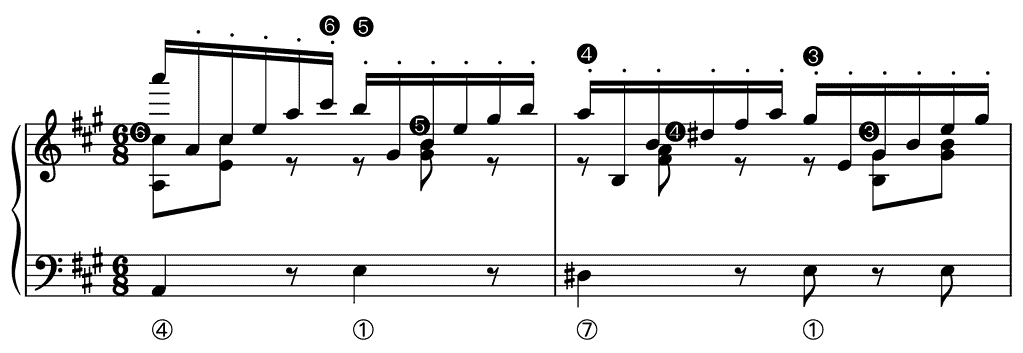
Prinner
B. Galuppi, Keyboard Sonata in B flat major I. 40/i, Larghetto, bars 1–5
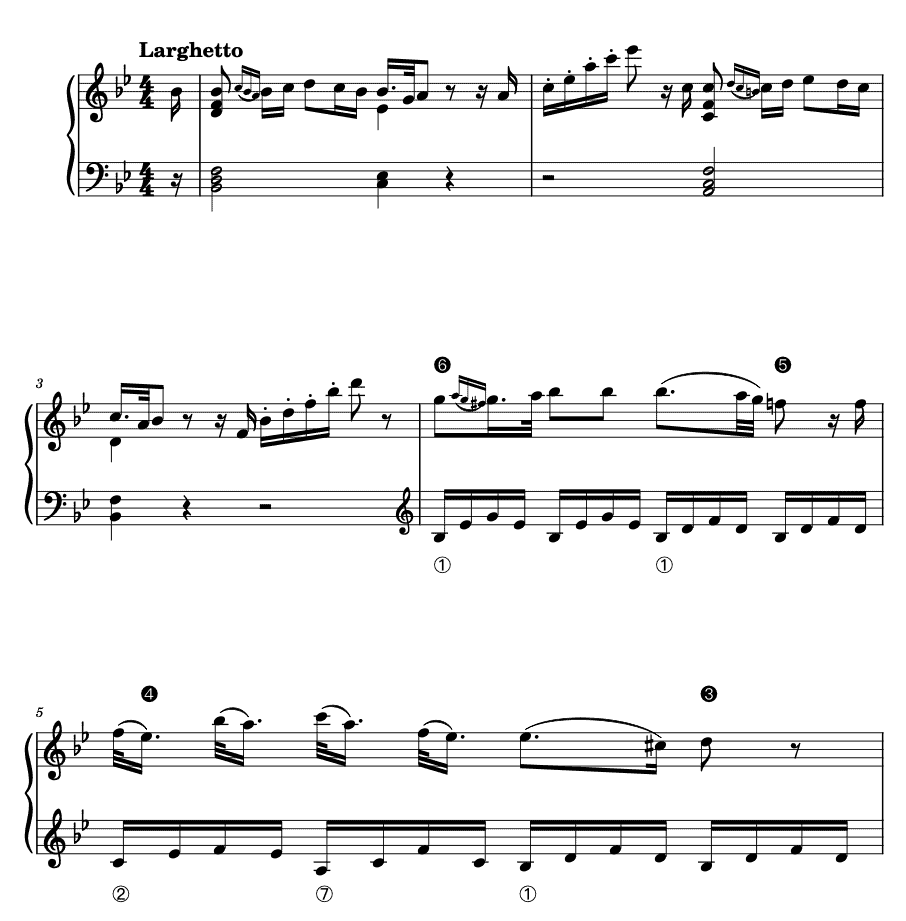
Prinner
J. Haydn, Keyboard Divertimento in F major Hob. XVI: 9/i, Allegro, bars 1–6

The Modulating Prinner
W. Wodiczka, Sonata for Violin and BC in B flat major op. 1 No. 1/ii,
Allegro ma non troppo, bars 1–9a (see bars 5–8a)
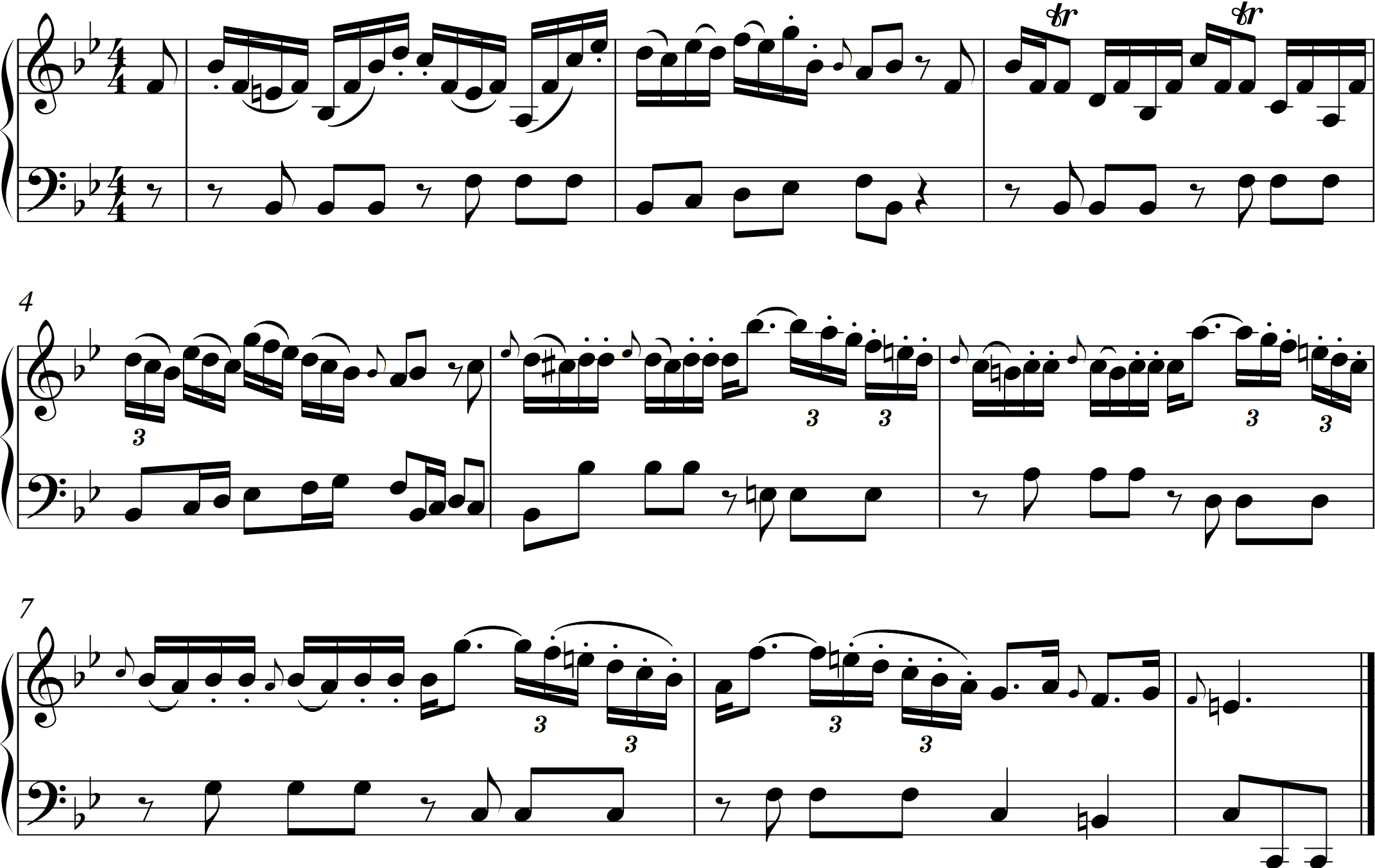
The Modulating Prinner
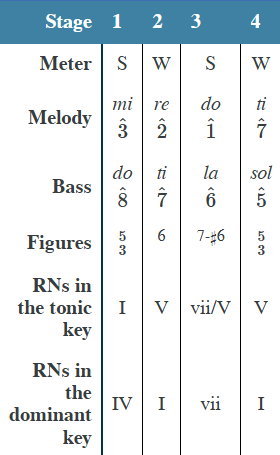
Incomplete Modulating Prinner
J. Haydn, Keyboard Divertimento in G major Hob. XVI: 8/ii, Minuet, bars 1–8 (see bars 5–6)
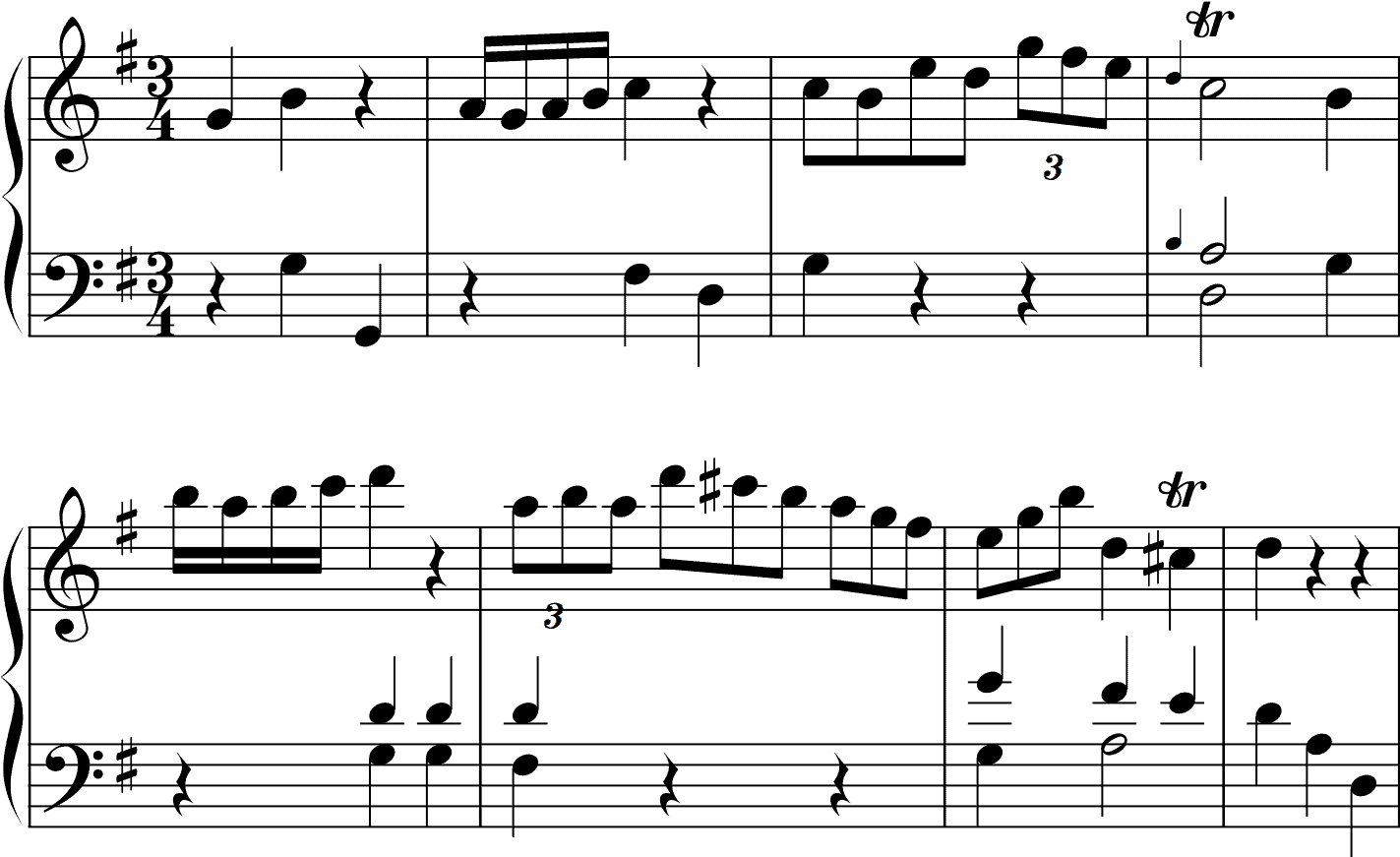
Canonic Prinner
While the bass usually starts on ④, the bass here starts on ⑥ to begin a stepwise descent. Since the ➏–➎–➍–➌ descent starts on the third stage, this extension creates a short canon between the outer voices.
Canonic Prinner
J. Haydn, Keyboard Sonata in D major Hob. XVI: 37/i, Allegro con brio, bars 1–4 (see bars 3–4a)

Circle-of-Fifths Prinner
Inserting an extra ⑤ or ⑦ in between ② and ① of a Prinner creates this.
Circle-of-Fifths Prinner
G.F. Handel, Keyboard Suite in G major HWV441/iii, Courante, bars 1–11a (see bars 5–11a)
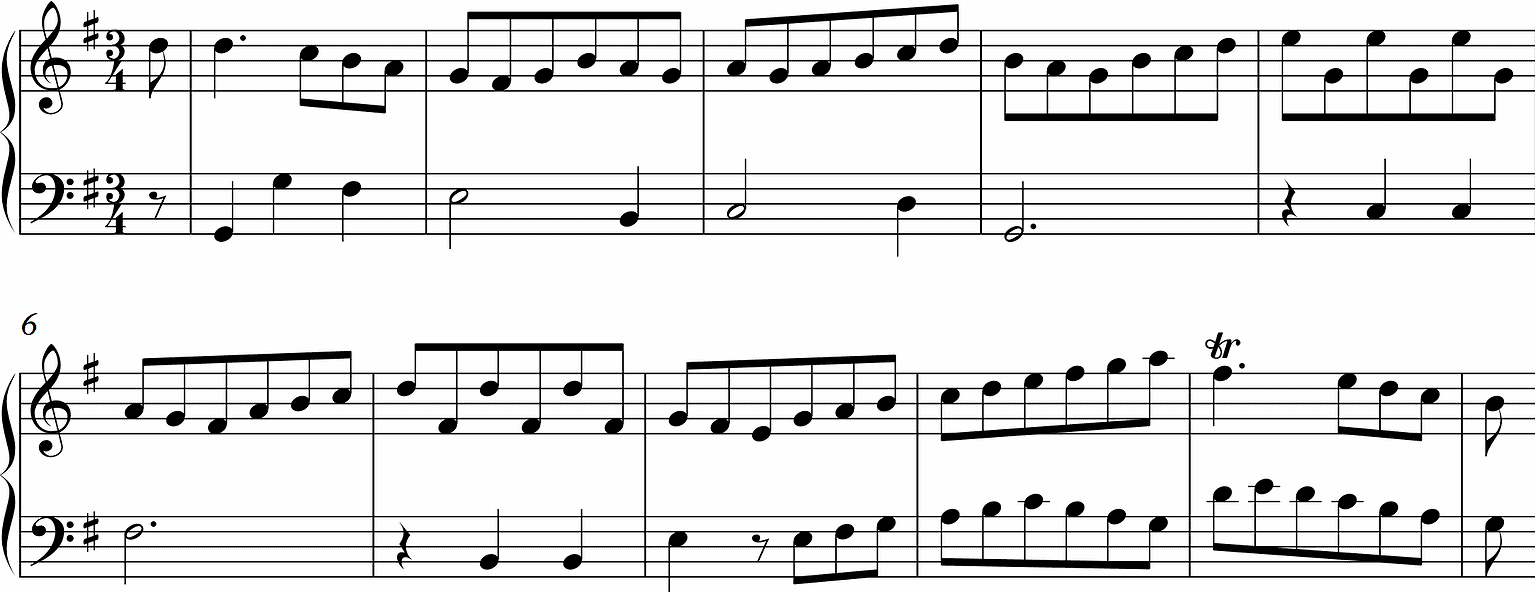
7–6 Fauxbourdon Prinner
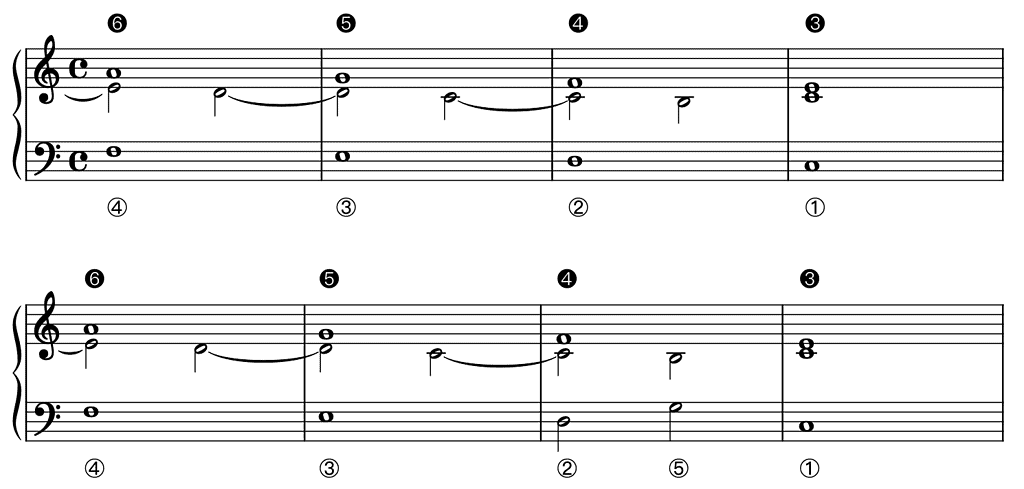
Stabat Mater Prinner
A dominant pedal point, a ➏–➎–➍–➌ descent in the top voice and a metrically shifted (➎–)➍–➌–➋–➊ descent in the middle voice, resulting in a chain of 2–3 suspensions. It occurs in major and minor.
Stabat Mater Prinner
G.B. Pergolesi, Stabat Mater, Amen (Presto assai), bars 45–51a

Stabat Mater Prinner
W.A. Mozart, Piano Concerto no. 9 in E flat major KV271 ‘Jeunehomme’, Andantino (in C minor), bars 96–100 (only strings)

Stepwise Romanesca
A descending sequential schema with 3 segments and 6 stages. Its basic features: a bass stepping down from ① to ③, a melody stepping down from ➌ to ➎ or alternately leaping up a third and down a fifth, each stage alternately set as a triad and a sixth chord.
Stepwise Romanesca in Two Parts

Stepwise Romanesca in Three Parts

Leaping Romanesca
A descending sequential pattern with 3 segments and 6 stages. Its characteristics: a bass alternating descending fourths and ascending seconds, a melody descending in stepwise motion starting on scale step 3, each stage set as a triad.
Leaping Romanesca
Johann Pachelbel, Canon in D major, bars 5–6a

Indugio - Converging Cadence
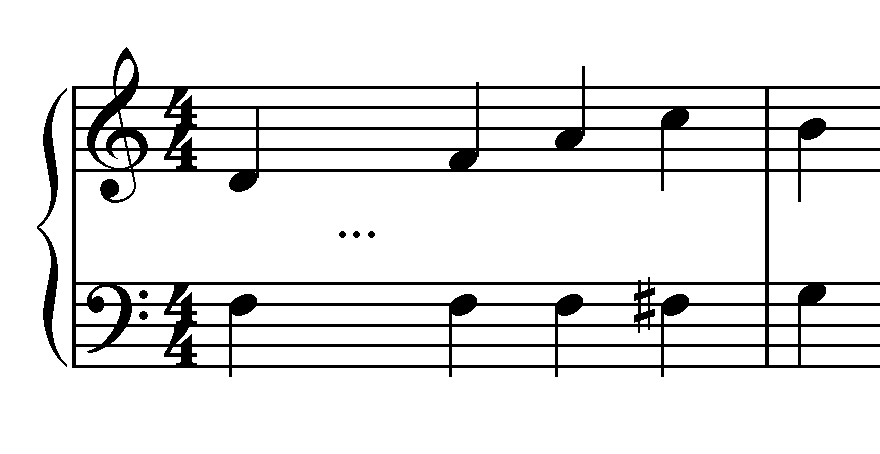
Fenaroli-Durante
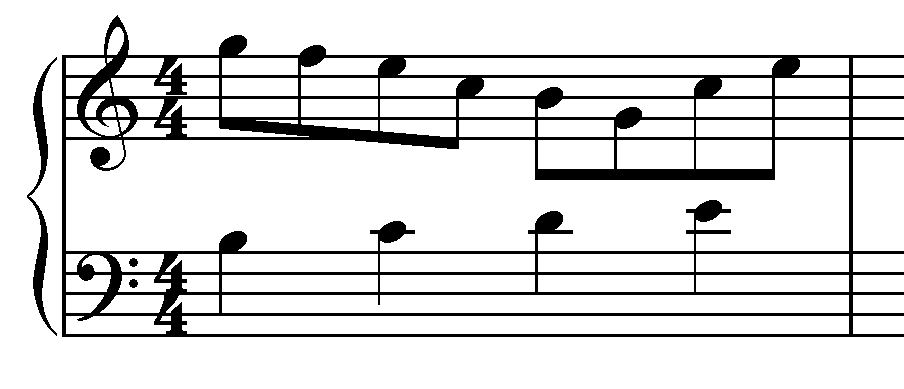
Canonic Fenaroli
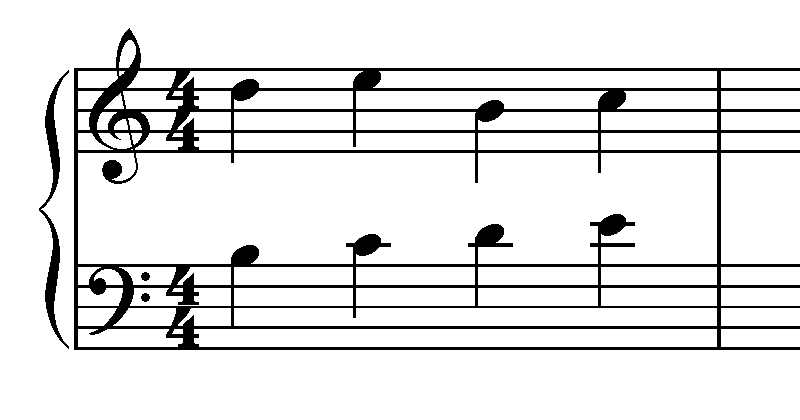
Fenaroli
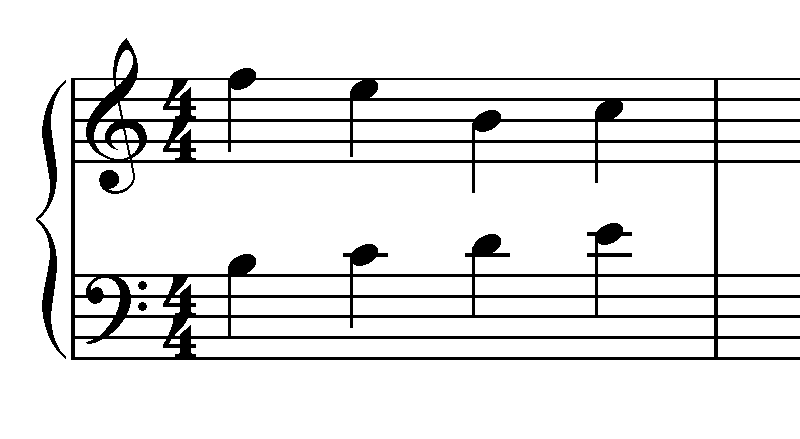
Ponte
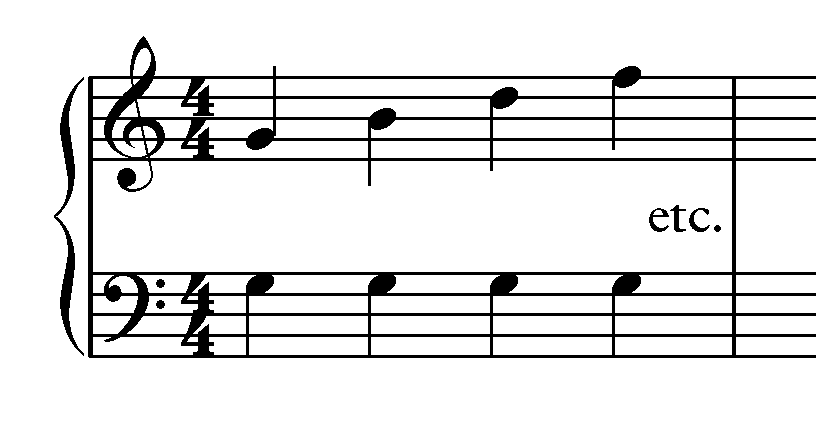
Monte
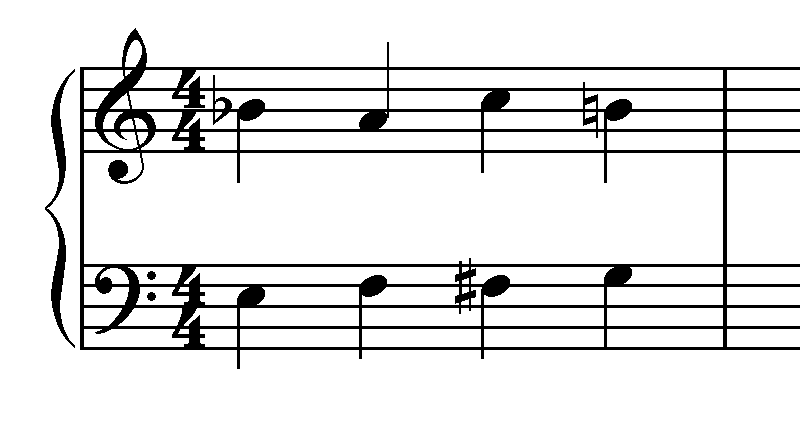
Fonte
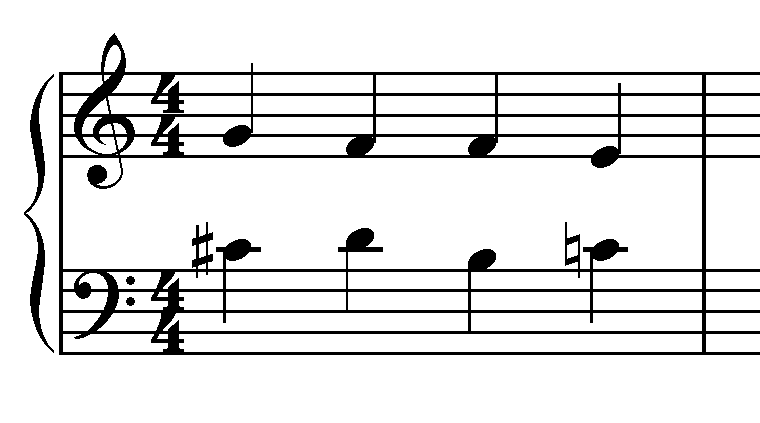
Prinner
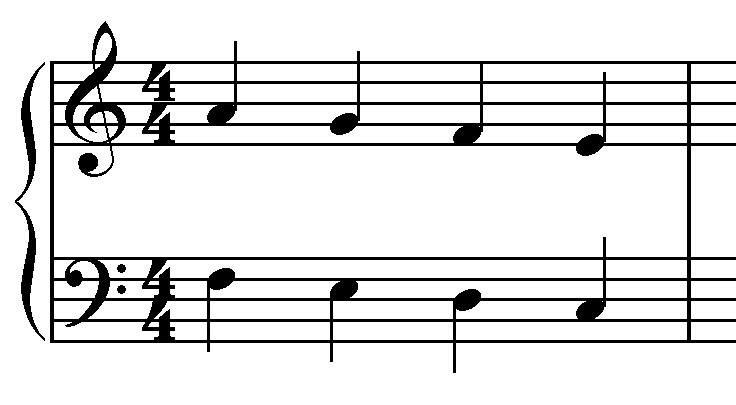
Sol-Fa-Mi
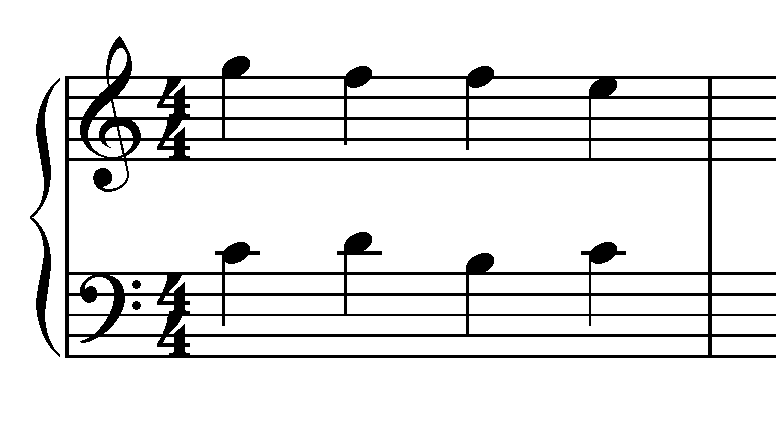
Do-Re-Mi
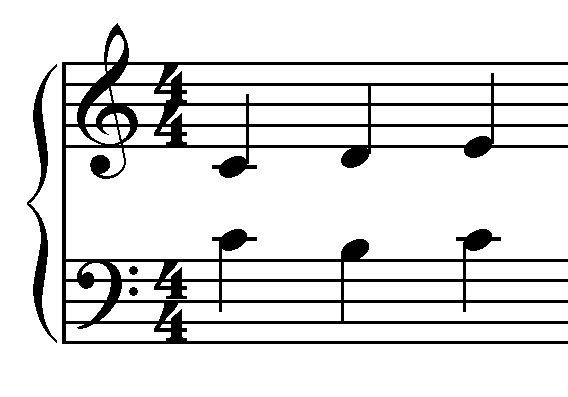
Adeste Fideles Do-Re-Mi
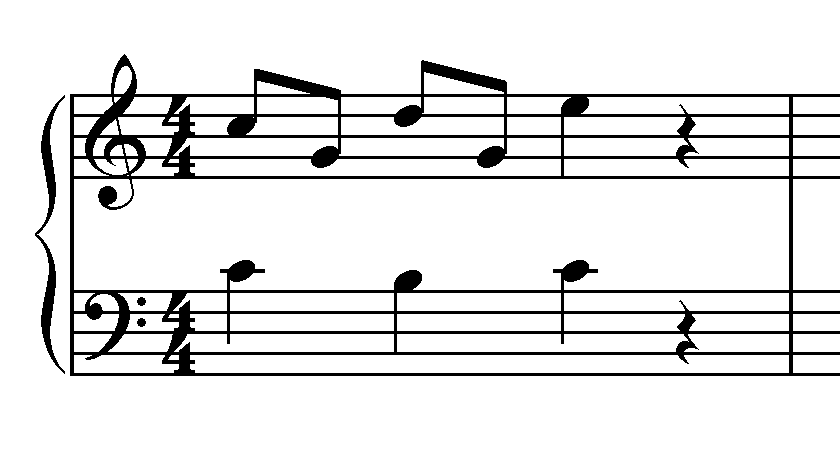
Aprile
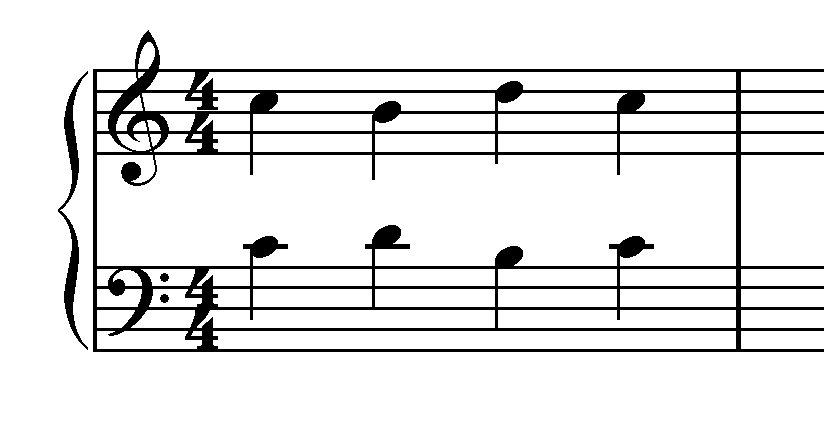
Pastorella
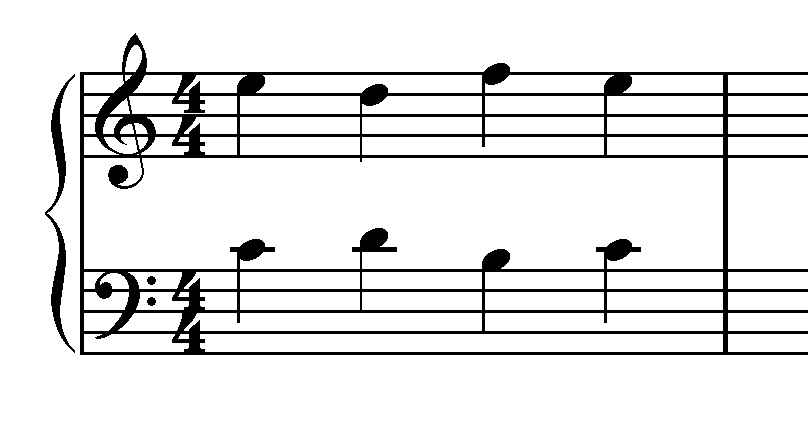
Jupiter
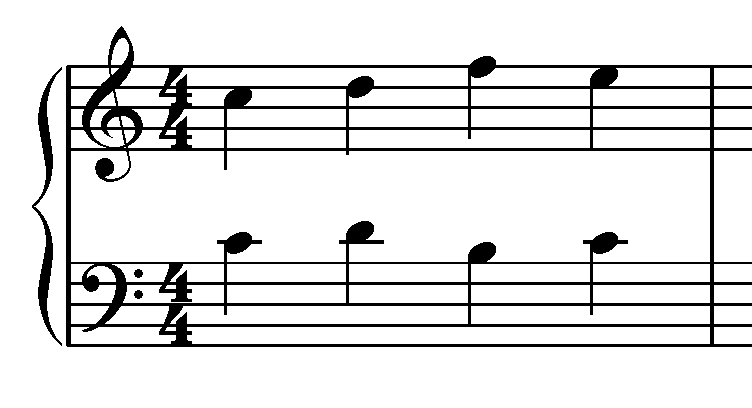
Meyer
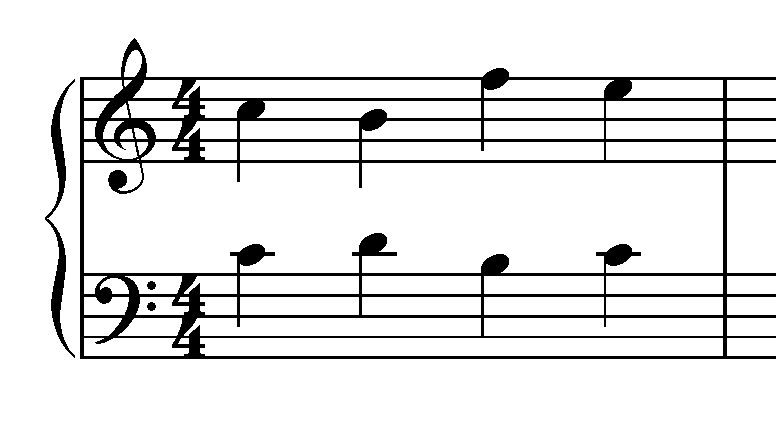
Leaping Romanesca
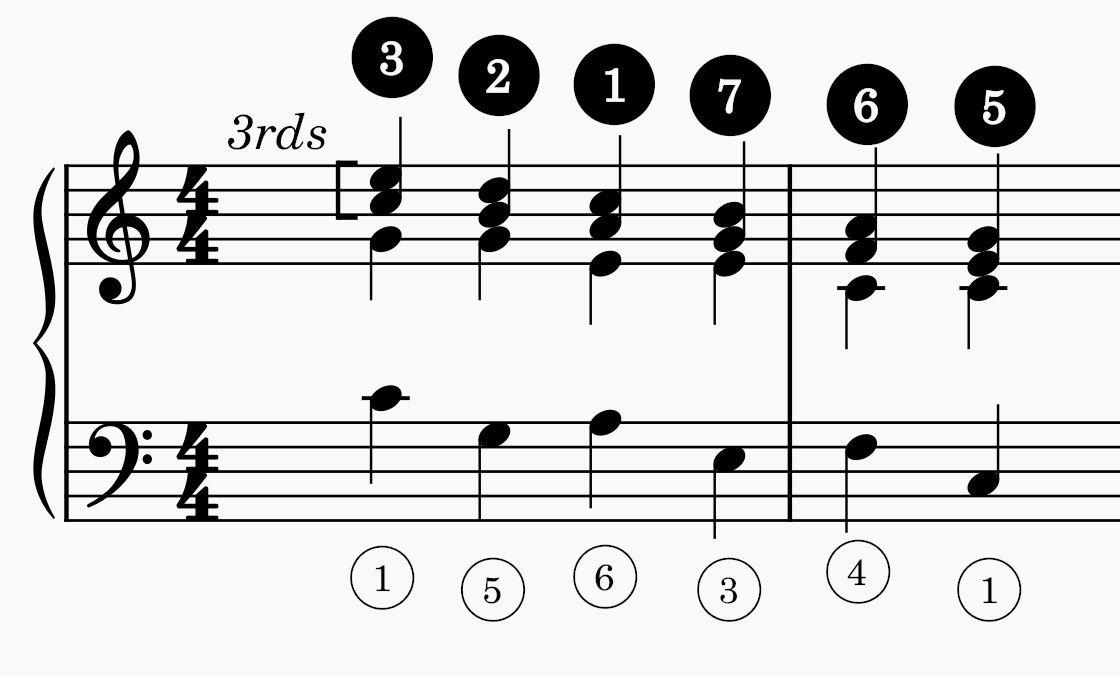
Stepwise Romanesca
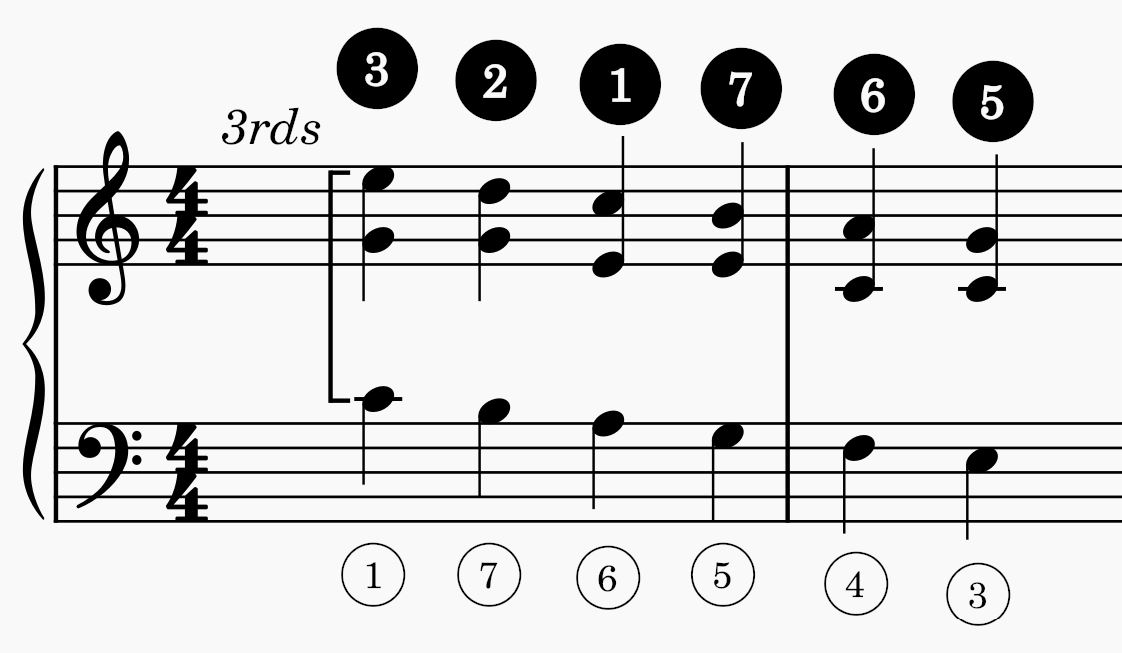
Romanesca
Melody: 1-5-1-1
Bass: 1-7-6-3
Metric polarity: Strong-weak
Variety: Opening
Prinner
Melody: 6-5-4-(2)-3
Bass: 4-3-2-(5)-1
Metric polarity: Strong-weak
Variety: Closing
Modulating Prinner
Melody: 3-2-1-7
Bass: 8-7-6-5
Metric polarity: Strong-weak
Variety: Closing
Fonte
Melody: 4-3, then 4-3 one step lower
Bass: 7-1, then 7-1 one step lower
Metric polarity: Weak-strong
Variety: Closing
Do-Re-Mi
Melody: 1-2-3
Bass: 1-7-1
Metric polarity: Strong-weak
Variety: Opening
Monte
Melody: 5-4-3, then 5-4-3 one step higher
Bass: 7-1 then 7-1 one step higher
Metric polarity: Weak-strong
Variety: Closing
Meyer
Melody: Open: 1-7, Closed: 4-3
Bass: Open: 1-2, Closed: 7-1
Metric polarity: Weak-strong
Variety: Opening
Quiescenza
Melody: b7-6-7-1
Bass: 1-1-1-1
Metric polarity: Weak-strong
Variety: Post-cadential
Ponte
Melody: 5-7-2
Bass: 5-5-5
Metric polarity: Strong-weak
Variety: Closing
Fenaroli
Melody: 4-3-7-1
Bass: 7-1-2-3
Metric polarity: Weak-strong
Variety: Pre-cadential
Sol-Fa-Mi
Melody: Open: 5-4, Closed: 4-3
Bass: Open: 1-2, Closed: 7-1
Metric polarity: Weak-strong
Variety: Opening
Indugio
Melody: 2...4-6-1-7
Bass: 4...4-4♯-5
Metric polarity: Strong-weak
Variety: Pre-cadential
Cadenza Semplice
Melody: 1-2-2-1
Bass: 3-4-5-1
Metric polarity: Weak-strong
Variety: Cadence
Cadenza Composta
Melody: 1-2-3-2-1
Bass: 3-4-5-5-1
Metric polarity: Weak-strong
Variety: Cadence
Cadenza Doppia
Melody: 4-3-2-1
Bass: 5-1
Metric polarity: Strong-weak
Variety: Cadence
Lully
I–II42–V65–I